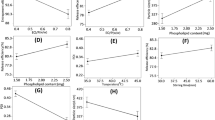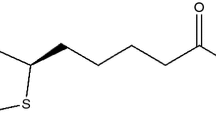Abstract
Biopolymers based on the pequi oil (Caryocar brasiliense Cambess) were synthesized in order to be implemented as drug vehicles. The polymers were characterized by various techniques. Associated with these techniques were the release tests (diclofenac sodium - DS) at pH 1.2 and pH 7.4. According to the results, the technique of FTIR and 1H NMR prove the effectiveness of the synthesis; the XRD technique confirms the amorphous nature of the polymers; the hydrophobic nature of the polymers was revealed by the test of the contact angle (with the P2 polymer having the lowest degree of hydrophilicity and the highest thermal stability according to the results of the thermal analysis (TG / DTG). The % of drug released was higher at pH 7.4 than at pH 1.2, for both P1 and P2, indicating that the polymers under study showed good pH sensitivity. None of the polymers has an oxidative potential. However, they present a significant potential to reduce the growth inhibition and to increase the survival of the Saccharomyces cerevisiae tested strains. The lowest concentration (100 μg mL−1) is considered to be the most effective, suggesting that the polymers under study can also be used for the development of biomaterials capable of reinforcing cellular antioxidative defenses.














Similar content being viewed by others
References
Jain JP, Modi S, Domb AJ, Kumar N (2005) Role of polyanhydrides as localized drug carriers. J Control Release 103:541–563
Vogel BM, Mallapragada SK (2005) Synthesis of novel biodegradable polyanhydrides containing aromatic and glycol functionality for tailoring of hydrophilicity in controlled drug delivery devices. Biomaterials 26:721–728
Poetz KL, Mohammed HS, Snyder BL, Liddil G, Samways DSK, Shipp DA (2014) Photopolymerized cross-linked thiol−Ene Polyanhydrides: Erosion, release, and toxicity studies. Biomacromolecules 15:2573–2582
Wafa EI, Geary SM, Goodman JT, Narasimhan B, Salem AK (2017) The effect of polyanhydride chemistry in particle-based cancer vaccines on the magnitude of the anti-tumor immune response. Acta Biomater 50:417–427
Hiew BYZ, Lee LY, Lee XJ, Gan S, Thangalazhy-Gopakumar S, Lim SS, Pan G, Yang TC (2018) Adsorptive removal of diclofenac by graphene oxide: optimization, equilibrium, kinetic and thermodynamic studies. J Taiwan Inst Chem Eng 0(0 0):1–13
Kierys A, Sienkiewicz A, Grochowicz M, Kasperek R (2018) Polymer-amino-functionalized silica composites for the sustained-release multiparticulate system. Mater Sci Eng C 85:114–122
Meng D, Zhang P, Li S, Ho C, Zhao H (2017) Antioxidant activity evaluation of dietary phytochemicals using Saccharomyces cerevisiae as a model. J Funct Foods 38:36–44
Teixeira INAO, Guariento ME (2010) Biologia do envelhecimento: teorias, mecanismos e perspectivas. Cien Saude Colet 15:2845–2857
Yin Y, Wang J, Yang X, Li W (2017) Removal of strontium ions by immobilized saccharomyces cerevisiae in magnetic chitosan microspheres. Nucl Eng Technol 49:172–177
Chaudhari AB, Anand A, Rajput SD, Kulkarni RD, Gite VV (2013) Synthesis, characterization and application of Azadirachta indica juss (neem oil) fatty amides (AIJFA) based polyurethanes coatings: a renewable novel approach. Prog Org Coat 76:1779–1785
Shaarani FW, Bou JJ (2017) Synthesis of vegetable-oil based polymer by terpolymerization of epoxidized soybean oil, propylene oxide and carbon dioxide. Sci Total Environ 598:931–936
Natarajan J, Rattan S, Singh U, Madras G, Chatterjee K (2014) Polyanhydrides of Castor oil-Sebacic acid for controlled release applications. Ind Eng Chem Res 53:7891–7901
Traesel GK, Menegati SELT, Santos AC, Souza RIC, Villas Boas GR, Justi PN, Kassuya CAL, Argandona EJS, Oesterreich SA (2016) Oral acute and subchronic toxicity studies of the oil extracted from Pequi (Caryocar brasiliense, Camb.) pulp in rats. Food Chem Toxicol 97:224–231
Machado MTC, Mello BCBS, Hubinger MD (2015) Evaluation of Pequi (Caryocar Brasiliense Camb.) aqueous extract quality processed by membranes. Food Bioprod Process 95:304–312
Traesel GK, Lima FF, Santos AC, Souza RIC, Cantadori DT, Kretschmer CR, Navarini VJ, Oesterreich SA (2017) Evaluation of embryotoxic and teratogenic effects of the oil extracted from Caryocar brasiliense Cambess pulp in rats. Food Chem Toxicol 110:74–82
Aguilar EC, Jascolka TL, Teixeira LG, Lages PC, Ribeiro ACC, Vieira ELM, Peluzio MCG, Alvarez-Leite JJ (2012) Paradoxical effect of a Pequi oil-rich diet on the development of atherosclerosis: balance between antioxidant and hyperlipidemic properties. Braz J Med Biol Res 45:601–609
Oliveira GLS, Oliveira FRAM, Alencar MVOB, Gomes Junior AL, Souza AA, Cavalcante AACM, Freitas RM (2014) Evaluation of antioxidant capacity of the aqueous extract of Cynara scolymus L. (Asteraceae) in vitro and in Saccharomyces cerevisiae. Afr J Pharm Pharmacol 8:136–147
Martínez LM, Videa M, Silva TL, Castro S, Caballero A, .Lara-Díaz VJ, Castorena-Torres F (2017) Two-phase amorphous-amorphous solid drug dispersion with enhanced stability, solubility and bioavailability resulting from ultrasonic dispersion of an immiscible system. Eur J Pharm Biopharm 119:243–252
Irin SC, DS EB (2014) Synthesis and characterization of biopolymers from linseed oil monoglyceride cyclohexane dicarboxylate with methyl acrylate and methyl methacrylate co-monomers. Int J Chem Sci Appl 5:30–37
Pongsathit S, Pattamaprom C (2018) Irradiation grafting of natural rubber latex with maleic anhydride and its compatibilization of poly(lactic acid)/natural rubber blends. Radiat Phys Chem 144:13–20
Colzato M, Forato L, Colnago LA, Assis OBG (2009) Identificação de produtos da oxidação de óleos comestíveis através da espectroscopia de RMN DE 1H. BioEng 3:259–268
Lopes RVV, Zamian JR, Resck IS, Sales MJA, Santos ML, Cunha FR (2010) Physicochemical and rheological properties of passion fruit oil and its polyol. Eur J LipidSci Technol 112:1253–1262
Wang F, Liu L, Zhang X, Weng L (2017) Hyperbranched unsaturated polyester resin for application in impregnation coatings. Iran Polym J 26:81–89
Murillo EA. e López BL (2015) Effect of the maleic anhydride content on the structural, thermal, rheological and film properties of the n-butyl methacrylate–maleic anhydride copolymers. Prog Org Coat 78:96–102
Mamat X, Wang Y, Eli W (2012) New potentially environmentally friendly copolymer of styrene and maleic acid-castor oil monoester. Polym Adv Technol 23:1271–1275
Assanvo EF, SD EB (2015) Synthesis and properties of Ricinodendron heudelotii oil based hybrid alkyd–acrylate latexes via miniemulsion polymerization. Prog Org Coat 86:25–32
Garcia CC, Franco PIBM, Zuppa TO, Antoniosi Filho NR, Leles MIG (2007) Thermal stability studies of some cerrado plant oils. J Therm Anal Calorim 87:645–648
Fernandes DM, Serqueira DS, Portela FM, RMN A, RAA M, MGH T (2012) Preparation and characterization of methylic and ethylic biodiesel from cottonseed oil and effect of tert-butylhydroquinone on its oxidative stability. Fuel 97:658–661
Silva TA, Assunção RMN, Vieira AT, Oliveira MF, Batista ACF (2014) Methylic and ethylic biodiesels from Pequi oil (Caryocar brasiliense Camb.): production and thermogravimetric studies. Fuel 136:10–18
Ma P, Cai X, Lou X, Dong W, Chen M, Lemstra PJ (2014) Styrene-assisted melt free-radical grafting of maleic anhydride onto poly(b-hydroxybutyrate). Polym Degrad Stab 100:93–100
Sharma RK, Lalita, Singh AP, Chauhan GS (2014) Grafting of GMA and some comonomers onto chitosan for controlled release of diclofenac sodium. Int J Biol Macromol 64:368–376
AL-Kahtani AA, Sherigara BS (2014) Semi-interpenetrating network of acrylamide-grafted-sodium alginate microspheres for controlled release of diclofenac sodium, preparation and characterization. Colloids Surf B: Biointerfaces 115:132–138
Rao KM, Kumar A, Han SS (2017) Poly(acrylamidoglycolic acid) nanocomposite hydrogels reinforced with cellulose nanocrystals for pH-sensitive controlled release of diclofenac sodium. Polym Test 64:175–182
Ansarypour Z, Shahpiri A (2017) Heterologous expression of a rice metallothionein isoform (OsMTI-1b) in Saccharomyces cerevisiae enhances cadmium, hydrogen peroxide and ethanol tolerance. Braz J Microbiol 48:537–543
Acknowledgments
The authors gratefully acknowledge the SEDUC-PI, SEMEC-Floriano-PI and CNPq: Process No. 311538/2017-7 and 310769/2014-0 and 457467/2014-2 (CNPq projects of J. E. Matos).
Author information
Authors and Affiliations
Corresponding author
Additional information
Publisher’s note
Springer Nature remains neutral with regard to jurisdictional claims in published maps and institutional affiliations.
Rights and permissions
About this article
Cite this article
do Nascimento, R.T., de Sousa e Silva, H., de Matos, J.M.E. et al. In vitro release and antioxidative potential of Pequi oil-based biopolymers (Caryocar brasiliense Cambess). J Polym Res 26, 183 (2019). https://doi.org/10.1007/s10965-019-1836-z
Received:
Accepted:
Published:
DOI: https://doi.org/10.1007/s10965-019-1836-z




